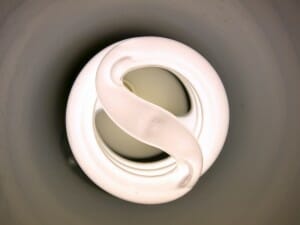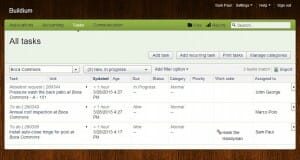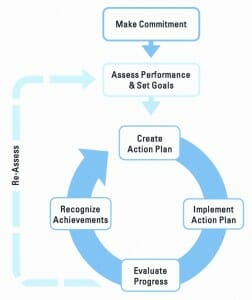The development and implementation of an energy-efficient maintenance system is a property manager’s best defense against hemorrhaging profits due to energy waste. Property managers can significantly trim their operating costs and cut their carbon emissions by implementing strategies to improve their building’s maintenance system.
Commercial real estate (multifamily dwellings, businesses, and industrial and retail property) accounts for almost 20 percent (1.3 metric tons) of America’s yearly greenhouse emissions. For most commercial establishments, energy use is the biggest operating cost, accounting for up to roughly one-third of the total operating budget.
Before you get your hands dirty, establish a clear objective for your building. What areas of energy consumption are you planning to improve upon, and how do you plan to do so? Make realistic goals – check the most recent national median source energy use for your building. Once you have established the goals of improving your building’s maintenance system, keep your momentum by constantly measuring and assessing its efficacy.
Reduce Operating Expenses
Make sure your building is completely weatherized. All windows and doors should be properly sealed (with spray foam, caulk, and/or weather stripping). Add a reflective roof coating to further reduce energy use and make sure your building’s insulation is adequate and intact. Keeping your building well-sealed is the easiest and least expensive way to save up to 10 percent on your commercial property’s energy bill and virtually eliminate draft, which no doubt will make your residents happy.

If you are not doing so already, use compact fluorescent light bulbs (CFLs) or light-emitting diodes (LEDs) in all common areas (laundry and community rooms, garages, hallways, etc.) These types of bulbs consume up to 75 percent less electricity than incandescent bulbs. Depending upon the size of your building, this can be an investment when done all at once, so plan for you or your maintenance team to replace halogen bulbs as they burn out with environmentally friendly alternatives. Encourage your tenants to replace their halogen bulbs with CFLs or LEDs as well. This might not lower your building’s energy bill if clients pay their own utilities, but it will contribute to lowering the overall greenhouse emission of your building, thus improving your image as an environmentally responsible business in the community.
Install energy-efficient appliances in both common areas (community washers and dryers) as well as individual units (refrigerators and air conditioners). Replacing old AC units with newer models minimizes air conditioning repair bills. More importantly, it also means a lower energy bill overall, since modern appliances must comply with recent regulatory guidelines, making them more efficient and environmentally friendly. Over time, any initial monetary outlay will be offset by lower energy bills. Even a 10 percent reduction in energy use can result in a 1.5 percent increase in net operating income.
Every good property manager knows that it is important to have an established plan of action when it comes to handling property maintenance services. For legal purposes, many property managers prefer to have their requests done in writing, either via email or handwritten note. An online maintenance request system is far more efficient and allows property managers and maintenance staff to see a request immediately, keep tenants updated, and keep a log of requests made and completed. This last characteristic is an important one: tracking success (and failures), as noted earlier, is a major consideration for property managers hoping to create an energy-efficient maintenance system.
The Role Tenants Play
Building residents play an important role in the proper implementation of an efficient maintenance system. A property manager cannot be everywhere at the same time in the building. Make sure your tenants are aware of their part in to reduce energy consumption, needless maintenance, and wasted money – both their own and yours!

Give your tenants several ways to get involved and report problem areas to you and the rest of the building staff so they can be attended to immediately. Often, the longer a problem goes unattended, the more money – not to mention frustration – it can end up costing. Consider adding an office line dedicated to receiving reports on maintenance problems that your tenants can either call or text. Establishing an online reporting system will allow your tenants can log maintenance requests or report problems, decreasing the workload on your team to take phone calls. Such a system will be able to notify all parties concerned so the issue can be resolved as quickly as possible. It will also keep a log of past requests, allowing you see at a glance where you’re spending the most time and money and to determine whether there is a possible solution to avoid doing so.
If your tenants are responsible for maintaining their own AC units, make sure they know the advantages of purchasing an energy-efficient model. They are bound to find a unit that suits their budget and lifestyle easily. Post eco-friendly reminders in prominent spots in the building as well as on every floor detailing ways to save electricity, tips on conserving water, etc. Impress upon them the simple truth: saving energy saves them money. In the end, who does not want that?
Encourage new and existing clients to create and maintain an energy-efficient home environment. As property managers, you should be a wealth of information and ideas for your tenants concerning energy-saving trends and current regulatory policies.
Protect and Increase Property Value
An energy-efficient maintenance system also helps to preserve the value of your property. Because of greatly improved technology, energy-saving devices and appliances not only perform better, they also last longer. A simple example would be installing compact fluorescent lights (CFLs) in the common areas; they typically last up to 10 times longer than incandescent bulbs, requiring less energy and less attention from your maintenance team. The bottom line is that efficient water fixtures and energy-saving appliances equate to an efficient maintenance system for your building. What’s not to love about less replacement work for your staff, lower repair costs for you, and a well-maintained building overall?
Measure and Share your Experience

According to the Energy STAR guidelines for energy management, the most crucial factor in seeing financial returns from implementing an energy-efficient maintenance program is to continuously assess performance and implement steps to increase efficiency even more. Be sure to measure and report the results of implementing your energy-saving maintenance system to all concerned and interested parties. This includes your tenants, of course, but you should consider sharing your experience with other property managers as well.
As property managers, you are accountable for maintaining the building and the grounds of the property that has been entrusted to your professional care. Ultimately, you are called to do your part in protecting and preserving the greater environment humans call home. Saving the planet is no longer the battle cry of a handful of environmentalists. More and more ordinary citizens, as well as policy makers, international organizations, and big conglomerates, are realizing that the importance of ‘green living’ goes far beyond some far-away marsh or rainforest; it affects our own health and wealth as well.
For more on green building, see Buildium’s Green Building Guide.
Read more on Maintenance

